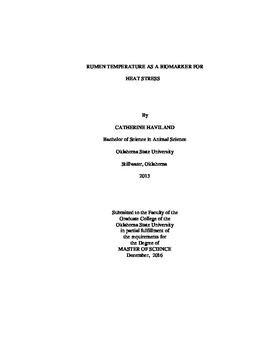| dc.description.abstract | Steers were randomized to 1 of 3 production systems, natural (NAT; did not received growth promoting technologies), conventional (CONV; received an implant on arrival and daily supplemented monensin and tylosin), and conventional with zilpaterol hydrochloride (ZH; CONVZ; fed ZH for the last 20 d of the feeding period). For the first experiment of 2 experiments; Experiment 1 (n = 108; initial BW 377kg) and Experiment 2 (n = 33; initial BW 357 kg) and all data was broken into 3 periods based on ZH period, PRE (7 d before), ZHF (20 d ZH feeding), and POST (3 d withdrawal). Steers received rumen temperature (Trum) boluses when sorted to production system pens. Respiration (RR) and panting scores (PANT) were taken during the ZHF and POST periods at 1000h and 1700h. Natural steers had lower average and maximum Trum, RES, and PANT; CONV and CONVZ steers had similar average and maximum Trum in the PRE and ZHF, but CONVZ steers increased in the POST. Conventional steers had increased ADG and BW over the NAT steers in both experiments. Overall, ZH did not have an effect on Trum until it was removed from the diet in both experiments. In the second experiment, NAT and CONV were used to determine the effect of housing on Trum, performance and carcass characteristics over an 84 d period. In the second experiment, production system (NAT vs CONV) steers (n = 54; initial BW 384 ± 2 kg) were housed in outdoor/indoor facility (SHADE) and steers (n = 54; initial BW 392 ± 2kg) were housed in open air pens (NOSHADE) for comparison. In the beginning of the feeding period, NAT NOSHADE had lower average and maximum Trum and CONV NOSHADE had the highest. For number of drinks daily, NAT NOSHADE steers had the most followed by NOSHADE CONV having the least. Performance were similar for SHADE and NOSHADE steers but BW was greater for NOSHADE; CONV steers had improved BW and ADG over the NAT steers. Back fat thickness, HCW, dressing percentage, LM area and marbling was effected by production system, but not housing. | |
